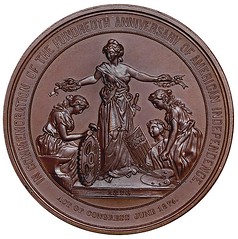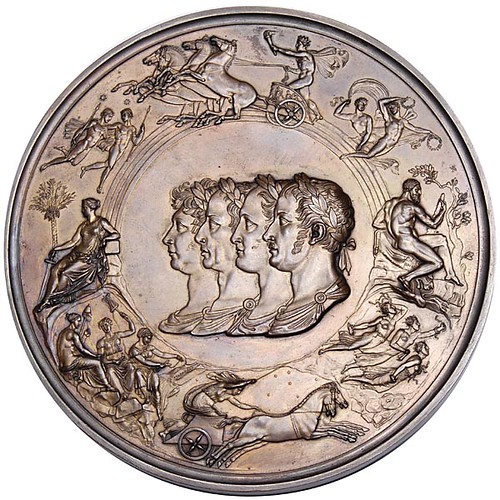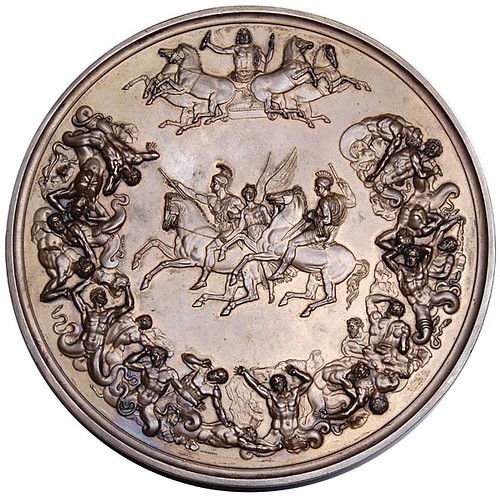
PREV ARTICLE
NEXT ARTICLE
FULL ISSUE
PREV FULL ISSUE
V11 2008 INDEX
E-SYLUM ARCHIVE
STACK'S SEPTEMBER COIN GALLERIES SALE
The September 10, 2008 sale by Stack's Coin Galleries
offers a number of interesting numismatic items, including 1876
Independence Centennial Medals, Bryan Money, Vernon Medals, and
Architectural Medals in addition to an assortment of U.S. and world coins.
At the right is lot 1909, an Independence Medal. 
To read the full lot description, see: Lot 1909: Independence Centennial Medal, 1876. 
One of my favorite lots in number 1732, an original 1849 Waterloo medal by Pistrucci. From the lot description:
Copper Electrotype, 134.7mm. By Benedetto Pistrucci. BHM
870 (RR), Eimer 1067. Obv. Laureate draped busts of the Allied sovereigns
who defeated Napoleon: Britain's Prince Regent (later King George IV),
Emperors Franz I of Austria, and Alexander I of Russia and King Friedrich
Wilhelm III of Prussia.
A competition was to be held among artists of the Royal Academy to choose a design, and a work of English artist John Flaxman was chosen. Italian engraver Pistrucci had just been appointed to the Royal Mint and refused to copy the work of another artist. He was then given the total responsibility for the Waterloo Medal, and prepared his first wax model within 24 hours for approval by the Prince Regent, who planned to present gold examples to the Allied sovereigns and the two Marshals.
Pistrucci received the then-enormous sum of 3,500 for this medal, equivalent to some $350,000 in present-day money. He then devoted the next 30 years to incessant squabbling with the Royal Mint administration over his titles and salary. King George IV objected to his florid laureate head on his first coins, but Pistrucci's 1817 Saint George and the Dragon is still employed today on Royal Mint Gold Sovereigns.
Pistrucci finally completed the massive Waterloo dies in late 1849. By now virtually all the recipients had died and the artist soon followed them. The mint was unwilling to risk hardening the long-delayed dies and instead ordered 20 Electrotypes prepared by Mr. Johnson of Bayswater along some in Gutta Percha, a natural resinous material. No struck medals in the original diameter were ever struck.
A competition was to be held among artists of the Royal Academy to choose a design, and a work of English artist John Flaxman was chosen. Italian engraver Pistrucci had just been appointed to the Royal Mint and refused to copy the work of another artist. He was then given the total responsibility for the Waterloo Medal, and prepared his first wax model within 24 hours for approval by the Prince Regent, who planned to present gold examples to the Allied sovereigns and the two Marshals.
Pistrucci received the then-enormous sum of 3,500 for this medal, equivalent to some $350,000 in present-day money. He then devoted the next 30 years to incessant squabbling with the Royal Mint administration over his titles and salary. King George IV objected to his florid laureate head on his first coins, but Pistrucci's 1817 Saint George and the Dragon is still employed today on Royal Mint Gold Sovereigns.
Pistrucci finally completed the massive Waterloo dies in late 1849. By now virtually all the recipients had died and the artist soon followed them. The mint was unwilling to risk hardening the long-delayed dies and instead ordered 20 Electrotypes prepared by Mr. Johnson of Bayswater along some in Gutta Percha, a natural resinous material. No struck medals in the original diameter were ever struck.


To read the full lot description, see: Lot 1909: Independence Centennial Medal, 1876.
Wayne Homren, Editor
The Numismatic Bibliomania Society is a non-profit organization promoting numismatic literature. See our web site at coinbooks.org.
To submit items for publication in The E-Sylum, write to the Editor at this address: whomren@gmail.com
To subscribe go to: https://my.binhost.com/lists/listinfo/esylum
All Rights Reserved.
NBS Home Page
Contact the NBS webmaster
